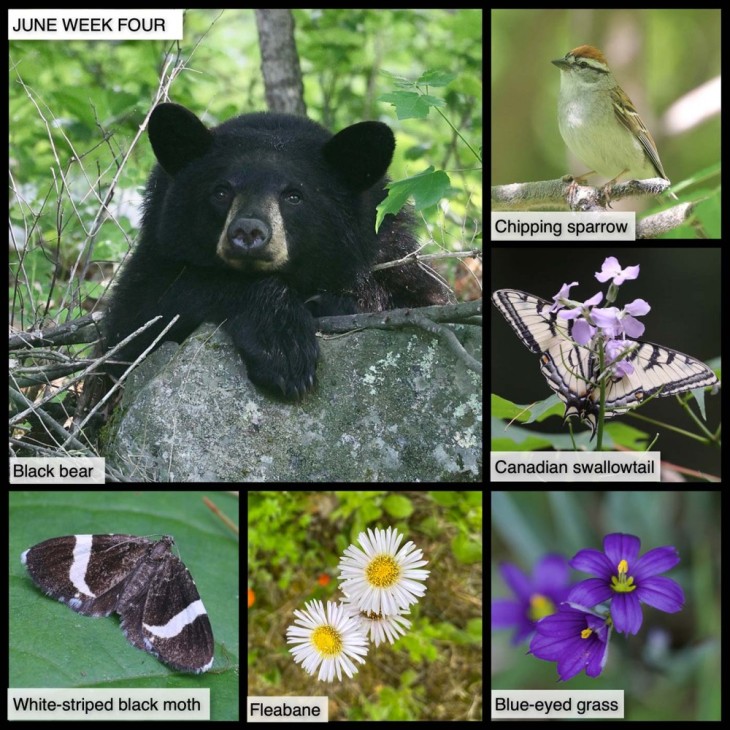This Week in the Woods we discovered a black bear dozing on a rock at the edge of a field. He (or she?) seemed unimpressed by the humans passing at a distance, and after a brief sit-up-and-sniff, dozed off again. As noted in editor Cheryl Daigle’s article about black bear monitoring in the Summer 2021 issue of Northern Woodlands magazine, food can be hard to come by for bears in June, as spring greens become less palatable and berries and other summer fare have yet to appear. Here’s an article by Susan Morse from our 2010 Summer Issue, focused on bear marks on trees.
Here are some other nature sights this week (clockwise):
Chipping sparrows sound as advertised. These common, rusty capped sparrows are a fixture of shrubby yards, and they build their nests fairly low – for example, at head height near the end of branch. We also often find them foraging in fields, noshing on weed seeds. Here’s a profile from The Cornell Lab’s All About Birds.
The easiest way to distinguish between a Canadian tiger swallowtail (pictured) and an Eastern tiger swallowtail is to look on the underside of the wings. As explained in this excellent blog post by Bryan Pfeiffer, the yellow line at the outer edge of a Canadian tiger’s wing appears as a band, versus a series of spots. However, the species hybridize, so looks vary.
Blue-eyed grass is blooming in fields and meadows on sunny mornings. There’s more than one species – here’s a list from The Native Plant Trust. We often find tiny bees crawling on its indigo petals.
Several species of fleabane, a genus of early blooming asters, are showing their many-petaled faces in the meadows. As explained in this post from the Brooklyn Botanic Garden, fleabanes get their name from their traditional use in sachets to repel fleas and other pests, but it’s doubtful that this use is effective. The BBG post also notes that fleabanes are popular perches for crab spiders.
Finally, we found this pretty moth hanging out on a sunlit leaf. This is a white-striped black moth and as noted on the site bugguide.net, it typically appears in damp, deciduous woodlands where its caterpillar host plant, jewelweed, often grows.
Our thanks to The Bailey Charitable Foundation and the Frank and Brinna Sands Foundation for helping to support this series.
In this difficult period, many of us find joy in observing local nature. This series, launched in April 2020, shares nature photographs taken in the past seven days, or in the same week in 2020, most within 15 miles of the Northern Woodlands office in Lyme, New Hampshire. We hope you enjoy using this grid as a prompt for your own explorations.
What are you seeing in the woods this week? Share your images with us on Facebook, or submit a special photo for possible inclusion in our monthly online Reader Photo Gallery.


